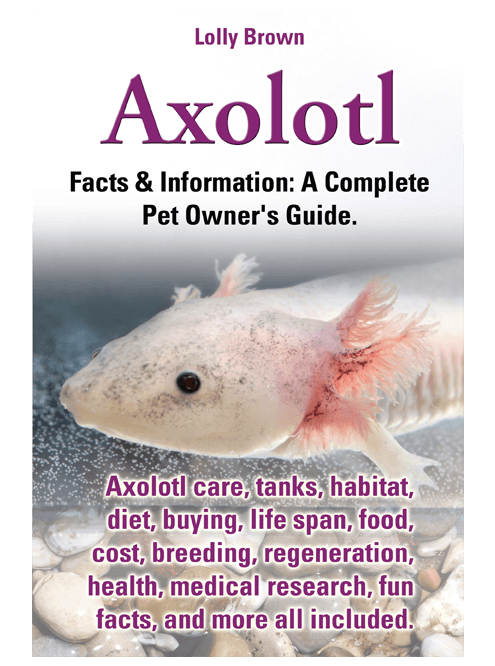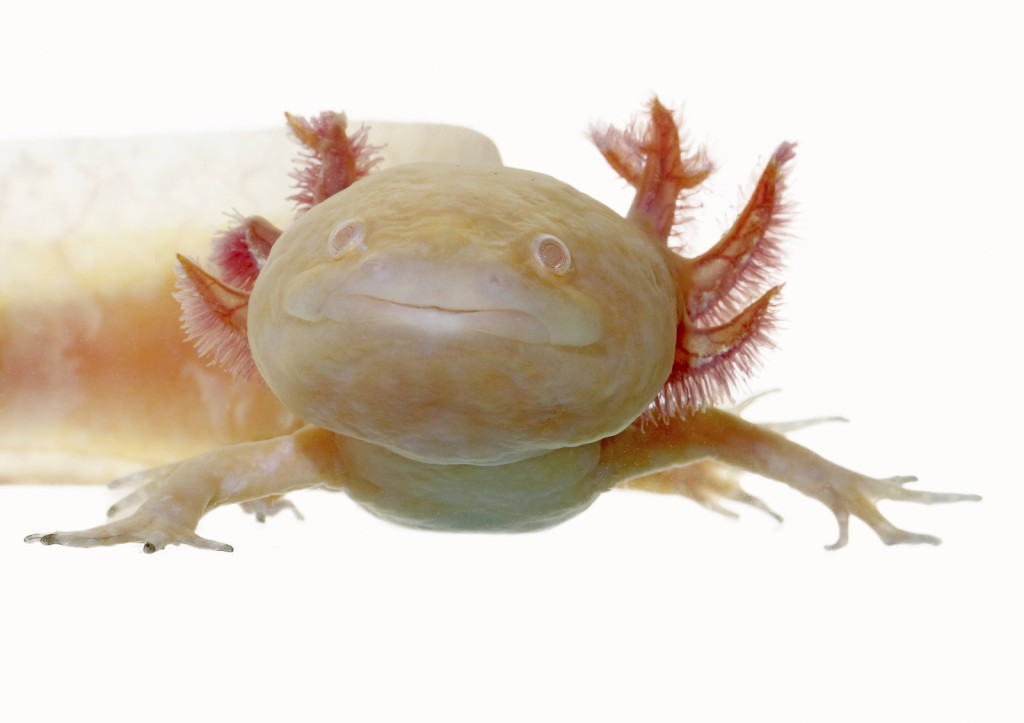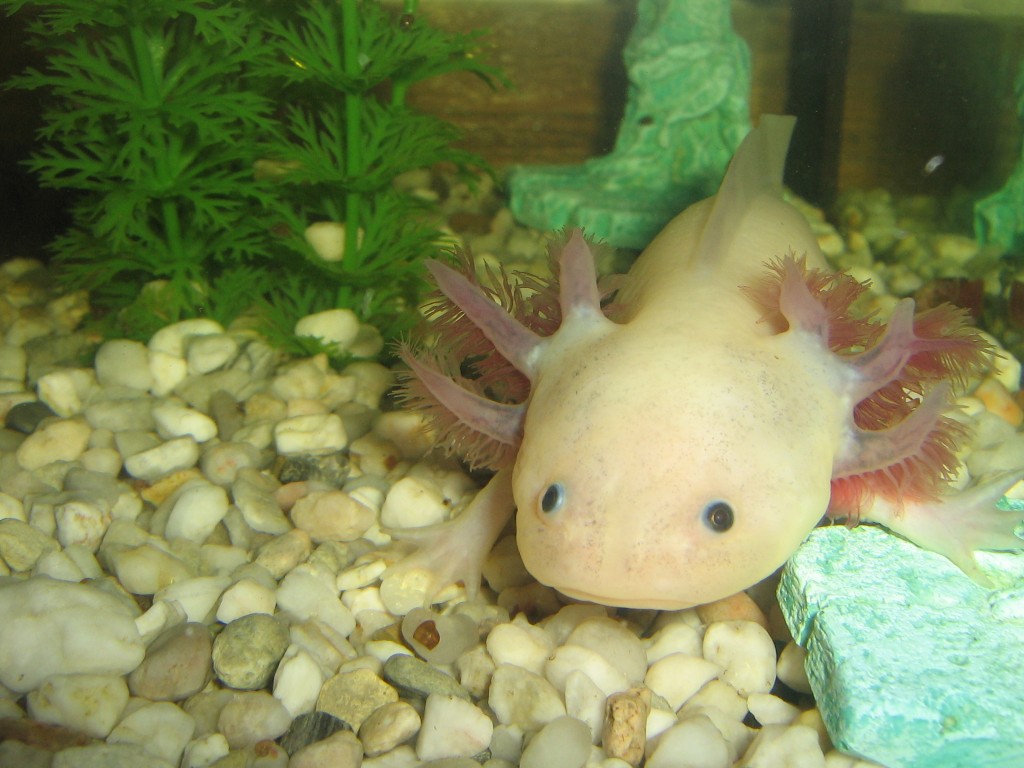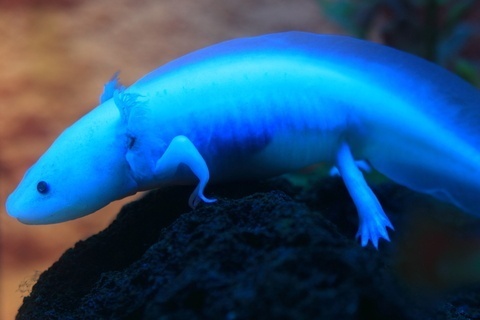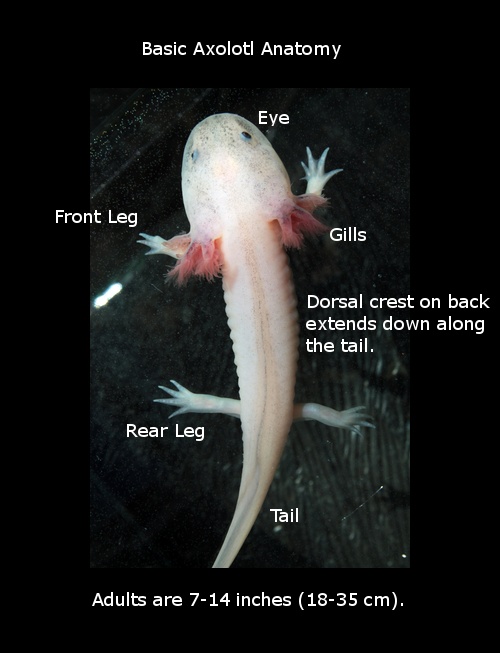CHAPTERS
Navigate to chapter
► Chapter 1: What is an Axolotl?
► Chapter 2: Keeping Pet Axolotls
► Chapter 3: Axolotl Health and Breeding
► Chapter 4: Axolotls and Medical Research
► SPECIAL – Appendix 1 – Overview of Tiger Salamanders
Chapter 1: What is an Axolotl?
The axolotl is an amphibious salamander (Ambystoma mexicanum), indigenous to Mexico. Sometimes called a “water monster” or Mexican Walking Fish, its name is derived from the Aztec language Nahuatl. The closest translation in English is “water dog.”
These unique creatures were once considered to be a culinary delicacy. They are mole salamanders, and are among the most primitive of their kind, diverging from other salamanders in their development more than 140 million years ago. This fact is only the first in a long list of items that make the axolotl a truly unique creature.
The first specimens appeared in Europe in 1863. Today, axolotls are rarely caught in the wild and are listed as a CITES endangered species.
Axolotls are, however, widely bred in captivity for their value in medical research involving limb regeneration, trauma, and anti-aging. Additionally, the large size of the species’ embryos makes them useful in a broad range of disease-related studies.
Hobbyists find the axolotl an intriguing choice among the many aquatic creatures that can be successfully housed in an aquarium. While fully-grown axolotls will live peacefully with one another, they can exhibit cannibalism when they are younger.
The axolotl is a fully aquatic species. They cannot survive out of water, and they are neotenous, meaning they remain in their larval form for life.
Axolotls are Neotenous
The reasons for the axolotl’s neotenous state are not clear. It may be a result of the species development in waters with insufficient stores of iodine.
This would compromise the presence of the hormone thyroxine in the salamander’s body and keep it permanently in its larval state.
Another theory suggests that water temperature may prevent the thyroxine from functioning appropriately.
Some experts even believe the axolotl de-evolved to a fully aquatic state because they were safer in the water than on land, a theory that extends to other species that naturally live in bodies of water at high elevations.
The axolotl has gills and fins, with only rudimentary lungs. The gills are, in fact, one of its most prominent features, rising in feathered pairs on either side of the salamander’s head. Technically called “rami,” the gills are full of capillaries or “fimbrea.”
As a neotenous life form, the axolotl is regarded as a backward step in evolutionary terms. It is thought to be an offshoot of the Tiger Salamander, a species with which the axolotl can breed successfully. (For more information about the Tiger Salamander, See Appendix 1).
If an axolotl is treated with hormones, it will metamorphose, but this rarely happens spontaneously. Claims by enthusiasts online that they have a creature that has done so are almost always a case of mistaken identity with a Tiger Salamander.
Physical Characteristics of the Axolotl
An adult axolotl measures 7-14 inches (18-35 cm). They are poikilothermic, meaning that their body temperature is completely dependent on their surroundings.
Temperature is, in fact, highly important in their care. They do not tolerate temperature fluctuations and need colder water than tropical fish.
Feathered Gills and Breathing
Their prominent and feather-like gills are highly functional breathing systems. The gills pull water through their membranous structure so the capillaries can extract oxygen from the liquid and feed it into the body.
In turn, the gills also pass waste carbon monoxide back into the water. The axolotl does not need to move for its gills to function. The structures move or wave gently on their own to perform their oxygen-gathering function.
The gills are obviously very fragile, but even if they are harmed, the salamander can still breathe quite well. The gills grow back quickly, and the axolotl actually has “back up” breathing systems.
Other Forms of Respiration
In addition to the use of its gills, axolotls are capable of cutaneous respiration. When the salamander moves, or when the water itself moves, oxygen passes through the creature’s thin skin and into its body.
Too much motion in the water, however, will stress an axolotl to the point of death.
Finally, axolotls also use buccal respiration via a flap at the back of the throat, the buccopharyngeal membrane. When water passes over the structure, oxygen is extracted. The same membrane functions to allow the axolotl to suck water into its mouth for feeding.
Although not sufficient to sustain breathing for long, the axolotl does have very primitive lungs. They can “sip” air at the surface, but more times than not, this does little more than cause them to swallow a bubble and float until they manage to burp!
(If an axolotl goes to the surface repeatedly to gulp air, something is chemically wrong with the composition of the water in the tank. The likely culprit is a build-up of toxic ammonia.)
Distinguishing Gender
It is extremely difficult to tell the difference between a male and female axolotl, which can lead to a lot of surprise births in captivity.
Any time that you choose to house two axolotls together, most anything can happen, so don’t be surprised if you find eggs in the aquarium.
Determining Sexual Maturity
At full sexual maturity, females appear rounder at the end of their bodies, while males are more elongated, with longer tails and a larger cloacal region, but often only an expert can make this distinction.
If the vent (the area behind the back legs and under the tail) is examined closely, both genders have a small bump that is actually a cloacal gland. In males, the bump is much larger.
In white, golden, and albino axolotls you can tell the animals are fully mature if their toes are dark brown, and the soles of their feet appear to be dirty. Other color types may have darker toe tips, but it’s more difficult to see.
Young axolotls will develop to adulthood in 18 months to two years. If well cared for, they can easily live to 15 years of age.
Color Variations and Types
There are no different types or sub-species of axolotl. Do not let breeders suggest otherwise when you are shopping for a pet.
These are highly specialized creatures indigenous only to the area around Mexico City, which largely explains the perils they face in the wild. Part of their unique nature lies in the fact that they have changed very little in their evolutionary history.
The spread of Mexico City has all but erased the axolotl’s native habitat and placed the creatures on the CITES endangered species list.
Although conservationists are laboring to create safe havens for them, the axolotl’s ultimate fate in the wild is highly questionable.
Known color variations of axolotl include:
– gray,
– various shades of brown,
– golden albino,
– black,
– cream,
– and piebald.
Wild specimens are the darkest in color.
Each type has a specific name, and often axolotls are sold according to this designation. The names do not, however, denote different species of axolotl. There is only the one type.
“Wild” or Brown Shades
The brown shades are the most common seen in axolotls, ranging from a warm tan to near black.
It is common for the body to exhibit some spotting or speckling and frequently the belly of the salamander is lighter than the back. In sexually mature adults, the toes often become pale.
This variety is, however, the most surrealistic looking, and is not as popular among enthusiasts who prefer more dramatic color variations.
Albino and Golden Albino
Any animal that is termed an albino lacks skin pigmentation and therefore appears to be white. Albino axolotls, however, can range from cream to yellow, and the body may seem to be shaded.
The real telltale sign of albinism, however, is the presence of red eyes. When albinos reach adulthood, their feet and toes are grayer in coloration.
Golden Albinos have a lovely, warm tone that can almost seem to glow. Like their paler cousins, however, they have the same red or bright pink eyes.
Typically albino axolotls have really beautiful gills that are pink or red, in striking contrast to the pale tone of their bodies. For this reason, their look is even more exotic. Arguably, these are among the most attractive members of this species, and highly popular as pets.
Melanoid
Axolotls termed “melanoid” do not display the typical shiny areas or “iridophores” generally seen on the body and around the eyes of this species.
These specimens are almost jet black, but often with a paler underside and toes, especially as adults.
Leucistic
This color variation is easily concerned with the albino axolotl. The skin is very light, but a leucistic axolotl’s skin does contain pigment, and can be speckled with black. When this occurs, the creature is said to be a “piebald.”
Also, a leucistic will not have red eyes, and their eyes are generally encircled with a black ring. They are also highly popular as pets because they sport the same pink gills as an albino, if in somewhat more muted shades.
Copper
Copper axolotls are most commonly found in Australia, where the species is the only non-native salamander that may be kept as a pet. The color is very much like caramel in most individuals, but can be much darker.
These axolotls also have red eyes, but that fact is often missed due to the color of the creature’s skin. The gills will be the same color as the salamander’s body.
Axolotl Biology
Because axolotls are completely aquatic even though they are amphibians, they cannot leave the water to colonize new habitats.
In an odd twist of fate, the fact that they have been cultivated for medical research has saved the axolotl from sure extinction. Now, in addition to their value as a lab animal, they are increasingly prized as exotic pets.
Although a carnivore, the axolotl has only pedicalate teeth that look like little cone-shaped stumps. The teeth can be used to grip food and to move it around in the mouth before swallowing, but the meal goes down whole.
Even if your axolotl should nip at you, the bite won’t hurt. The little guy just doesn’t have the equipment to do any damage.
Like all amphibians, the axolotl has a three-chambered heart and, as mentioned, rudimentary lungs. This is not, however, a typical feature of their kind.
The vast bulk of amphibians can live in the water or on land. Axolotls, however, will die if kept out of their aquatic habitat for too long.
Regenerative Abilities
These salamanders are famous for their ability to regenerate their limbs within a few weeks. Any damaged appendage will form a bud from which a new foot or leg develops. It is even possible for an axolotl to regrow portions of its spine and brain.
Occasionally, this regenerative ability goes awry, and a perfectly healthy axolotl with four functional legs will suddenly grow a fifth appendage. This is nothing to worry about, and could be a consequence of the degree to which axolotls have been inbred in captivity.
As long as the axolotl is able to function normally, and can feed, it doesn’t matter how many limbs it does or does not have. If, however, an additional growth or appendage is causing the salamander to suffer, the advice of a veterinarian should be sought.
Although no one likes to contemplate intentional cruelty, it must be emphasized that you should never inflict any kind of damage to your axolotl, no matter how minor, for the purposes of witnessing their regenerative powers.
Young axolotl heal very quickly, and are often able to replace a lost or damaged limb within a month. Older animals may require several months. The process is not effortless by any means, and becomes more and more difficult as the salamander ages.
Want to read the entire thing?
